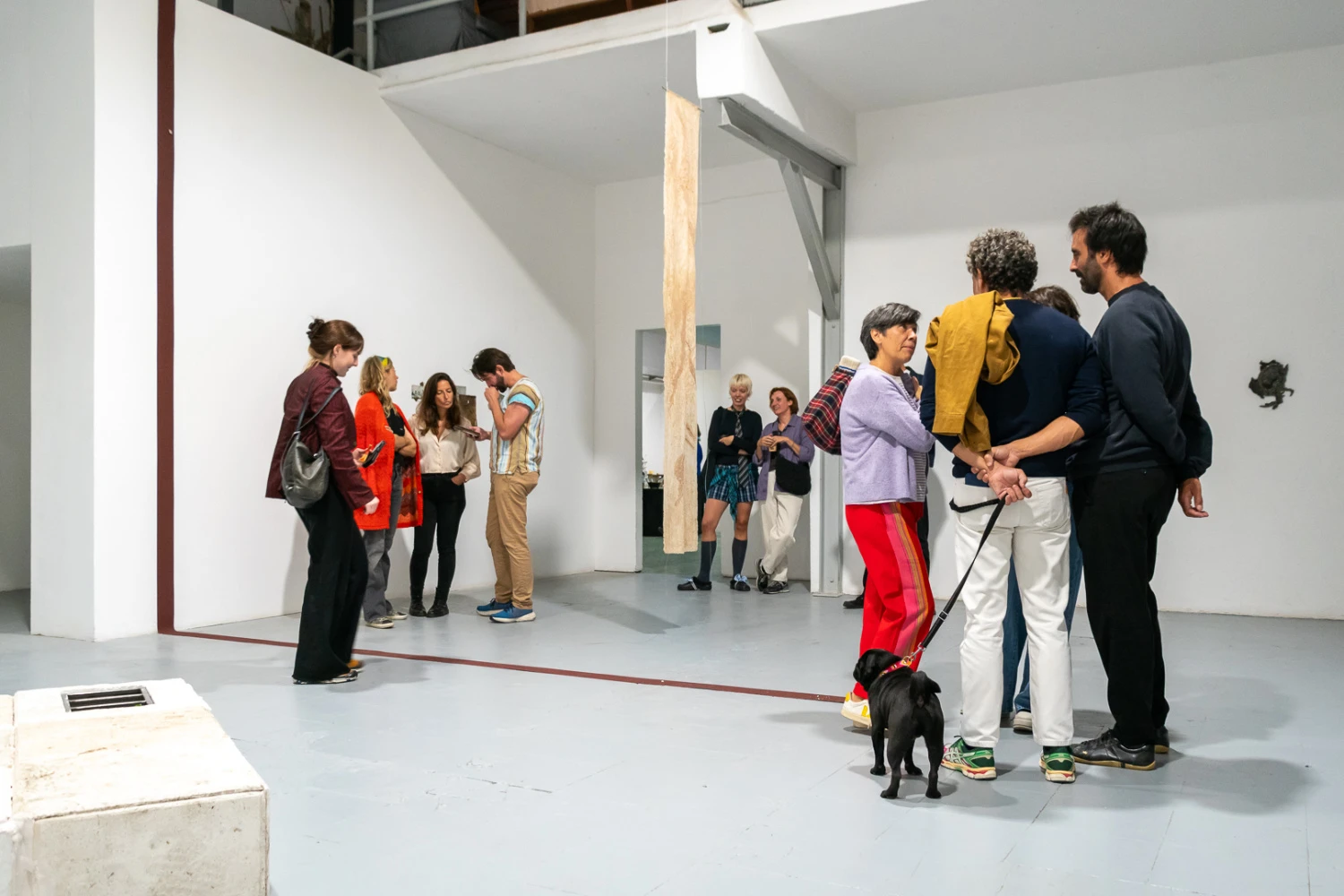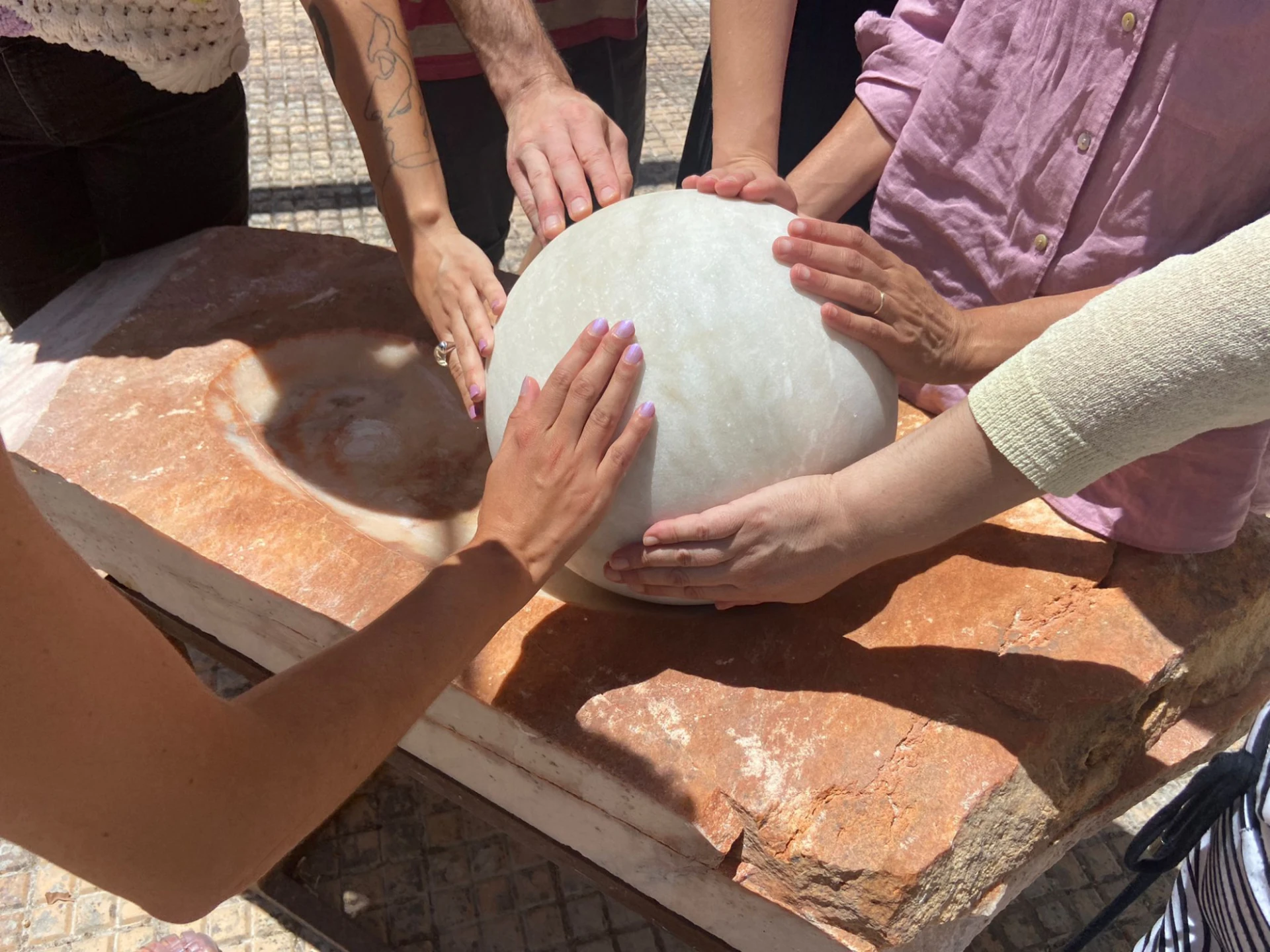article
3 Projects X 3 Encounters: Sharing Knowledge
The second meeting of 3 Projects X 3 Encounters was dedicated to understanding artistic residencies as proto-educational formats and to interconnecting the perceptions of the three participating structures on the theme. At the table, AiR 351, PADA Studios and pó de vir a ser exchanged ideas on the conception of artistic residencies as places of learning, sharing experiences and organically exchanging knowledge, made possible by the organisation that these same structures conceive and build.
Assuming that the terms in which education is practised could be a path towards social reconfiguration that better activates the fundamental values of democracy and culture from which we have emerged, it is inevitable to consider the models in which this occurs. This is especially true when we refer to artistic learning outside conventional models.
With this in mind, the second meeting of 3 Projects X 3 Meetings was dedicated to understanding artistic residencies as proto-educational formats and to interconnecting the perceptions of the three participating structures on the subject. At the table, AiR 351, PADA Studios and pó de vir a ser exchanged ideas on the conception of artistic residencies as places of learning, sharing experiences and organically exchanging knowledge, made possible by the organisation that these same structures conceive and build.
In agreement, artistic residencies were described as places of continuity and recovery of critical dialogue, so often lost after leaving academia, to which artistic practice and recognition are increasingly affiliated. After leaving university —where classes encourage questioning and shared studios are places where these same questions are discussed and influences occur naturally—many artists find themselves unexpectedly isolated. Practice becomes mediated by established artistic circuits, and places for discussion and disinterested sharing become scarce.
Assuming, in a second consideration, that artistic practices can be one of the ways of maintaining sensitivity within the social model in which we find ourselves, the connection between emotion and education becomes closer. Emotion, etymologically linked to movement, implies that feeling is not just reacting, but a shift outside ourselves, establishing connections and making room for the other. In this reading of arts education combined with emotion and encounter, everything related to art can be taken as a place of experimentation and as a place of empathic experimentation, in a second reading. In works or processes, places of attention to the other, of consideration for the other, can be rediscovered, without this being reduced to commercial dynamics.
In the course of practical life —in the professionalisation of artistic activity— what is the role of structures that facilitate artistic residencies in maintaining artistic learning, guided by the emotional and human dimension? In order to consider the question fairly, it is necessary to consider the particularities of the programmes and formats of artistic residencies developed in each of these structures.
In the case of PADA, a structure founded and managed by artists, the motivation to create a place that would continue a learning path has been present since its creation. The shared, wall-less studios were designed as an extension of a school space, without any associated didacticism, but with the possibility of fostering dialogue and sharing. The residency programme grew organically as the team transformed, remaining focused on the coexistence of groups of artists who share not only studio work, but also meals, accommodation and mundane responsibilities. This practical, everyday and collective dimension leads the artists participating in its programmes to a sense of community that favours mutual learning.
In addition to offering studios and mentoring, the residency also allows the artists themselves to develop workshops or classes, in an exercise of transmitting technical and conceptual knowledge. Although priority is always given to residents, there is also a desire to give back this knowledge to the public, namely through digital platforms that can disseminate the information gathered. The return on investment for the artists is marked by the intensity of the connections created, both in terms of the diversity of backgrounds, ages and pathways, and the quality of the exchanges between generations.
In its current form, the residency programme necessarily takes on different contours, linked to the specificity of the disciplinary and conceptual exploration of stone sculpture and the long history of the project itself. Its facilities offer not only the possibility of learning and technical exploration, but also the possibility of research, providing tools that are difficult to access outside the university environment. Given these characteristics, the residency has naturally become an alternative to a formal pedagogical model within stone sculpture.
The programme is mainly divided into two strands: short-term residencies, aimed at artists who do not usually work with stone sculpture but who find it a field of experimentation; and longer residencies, lasting two to three months, aimed at artists who have already mastered the technique and want to devote their time at the residency to producing stone sculptures. The artistic residencies involve public sharing specific to each work and its time frame. The Open Studios are moments of encounter between artists and the public, consisting of sharing the work in progress during the residency. For this reason, and due to the interdisciplinary nature of working with stone at pó de vir a ser, they are diverse in their presentation, as well as in the forms they take. The opening of the doors of the old slaughterhouse in Évora is a significant moment for pó de vir a ser's discourse in the territory and for its relationship with its audience through, precisely, artistic work. Responding to another temporal regime of working with stone at pó de vir a ser, the residencies — or long-term collaborations with artists — are a means and a mode of production for collective and individual exhibitions, as well as a fundamental axis for the consolidation of institutional partnerships.
The monitoring, programmed by Mariana Mata Passos, is carried out in several dimensions: technical, artistic and theoretical. There is support from specialists, such as sculptor Pedro Fazenda and artist Eduardo Freitas, visits to quarries, access to a library dedicated to sculpture, especially stone sculpture, and meetings with critics, curators, or other cultural actors who accompany the research of the resident artists. Stone inevitably imposes itself as a material and context, even when it is not transformed into the final work, influencing other practices such as photography or installation.
AiR 351 offers studios but does not have an exhibition space on its premises, favouring assisted or curated residencies, understood as a mediation between artistic production and reception by the public. The focus of this structure is on supporting the different investigations it hosts, supporting research and building bridges for artists to establish dialogues, whether with the place, with peers or with other fields of knowledge. Most of the residencies are individual and designed to respond to the different needs of the resident artists, but research groups have also been developed that bring together artists, curators, philosophers, and other cultural professionals around shared themes. In both cases, the mission and desire are similar: to learn and teach communally, expanding artistic practice through transdisciplinary interactions. Although it does not see itself as a formal educational structure, nor even clearly as informal education, AiR 351 sees itself as a place of continuous learning, respecting the specificities of each practice and supporting its needs.
The communities that are formed from AiR 351 are less marked by the sharing of studios and more by visits to individual studios and daily interaction in common spaces, such as the kitchen or the outdoor patio. Although individual studios provide concentration, it is in the need to prepare meals or in the domestic routine that encounters emerge. It is also this communality that motivates many artists to return.
Although the meeting began with the word education, associated with the expression informal, it became clear during the course of the meeting that the discussion was directed towards the idea of learning. Even when informal, education implies a set of agreed norms, a consensual direction. Learning implies a path or a time in which the act of learning occurs, without pre-established norms.
In each structure, the artist residency is conceived as a space for shared learning; it is understood as a continuous process of exchange, in which artists, curators, and transient communities invent ways of living and creating. These paths and durations occur distinctly, starting (or not) from the school experience that is intended to be recovered, offering technical learning paths that necessarily carry educational characteristics, but to which reflections are added and images of good practices are dispelled, favouring research and mediation, with flexible and individualised formats.
This is how these residences work: as places of learning where rules are improvised so that learning can take place collectively, different paths are welcomed, and each artist is allowed to find a way to learn and teach, to create and to feel.
BIOGRAPHY
Catarina Real (1992, Barcelos, Portugal) works at the intersection of artistic practice and theoretical research in the expanded fields of painting, writing and choreography, mostly in long-term collaborative projects that address the question of how we can live better collectively.
She is a doctoral student at the Centre for Humanistic Studies at the University of Minho with research that crosses art, love and capital. She maintains a practice of commenting - in the form of reflective texts, introductory texts to exhibitions, interviews and moderating conversations - on the works and processes carried out by artists in her generational group, with the intention of contributing to a healthy environment of criticism and collective and community creation. She has been vice-president of the French association Artistes en Résidence since 2019 and editor at Edições da Ruína since 2022.
ADVERTISING
Previous
article

05 Nov 2025
Fading and Enduring: Saodat Ismailova’s Poetic Geography at Kunsthalle Lissabon
By Orsola Vannocci Bonsi
Next
agenda
06 Nov 2025
Umbigo #94 - Fantasy / Sci-Fi
By Umbigo
Related Posts


